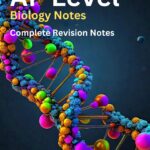 AP Biology Note – College Board AP® Biology Study Notes
AP Biology Note – College Board AP® Biology Study Notes
College Board AP® Biology Study Guides. Concise resources for the College Board AP® Biology course.
AP Biology is an advanced placement course offered by the College Board in the United States, designed to provide high school students with a college-level foundation in biology. It covers a wide range of topics, including:
- Molecular Biology and Biochemistry: The structure and function of biological molecules like DNA, proteins, carbohydrates, and lipids, as well as how these molecules contribute to cellular processes.
- Cell Biology: The study of cell structure, function, and processes, including cellular communication, energy transformation (e.g., cellular respiration, photosynthesis), and cell division.
- Genetics: The principles of inheritance, molecular genetics, gene regulation, and biotechnology techniques like DNA replication, transcription, and translation.
- Evolution: Understanding evolutionary theory, natural selection, genetic drift, and the history of life on Earth.
- Ecology: The interactions of organisms with each other and their environment, including ecosystems, population dynamics, and biodiversity.
- Organismal Biology: The structure, function, and development of plants and animals, including physiology and behavior.
The course is rigorous and focuses on critical thinking, experimental design, and data analysis, preparing students for further studies in biological sciences. At the end of the course, students take the AP Biology exam, which can earn them college credit or advanced standing depending on their performance and their college's policies.
Check our - AP Biology Score Calculator
8 units
·
236 lessons
|
Last updated: November 25, 2024
|
Please login to save the post
Notes
Flashcards
Questions
MCQ Quiz
Exam Study Notes
8 units
·
236 lessons
4 topics
3 topics
8 topics
4 topics
9 topics
5 topics
10 topics
3 topics
4 topics
2 topics
5 topics
3 topics
4 topics
8 topics
8 topics
2 topics
4 topics
12 topics
5 topics
8 topics
4 topics
9 topics
5 topics
9 topics
10 topics
3 topics
11 topics
12 topics
8 topics
8 topics
7 topics
4 topics
4 topics
10 topics
4 topics
3 topics
2 topics
5 topics
7 topics
Flashcards
Will be Added soon.....
MCQ Quiz
1 found this helpful out of 1 votes
Helpful: 100%
Helpful: 100%
Was this page helpful?
